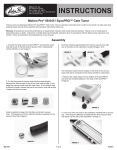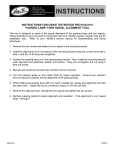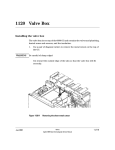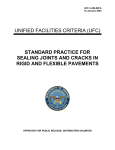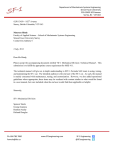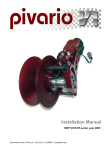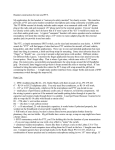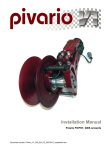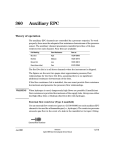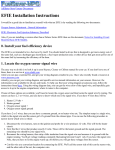Download Motion Pro 08-0411 SyncPRO™ Carb Tuner Instructions
Transcript
Motion Pro® 08-0411 SyncPRO™ Carb Tuner Instructions Thank you for purchasing the Motion Pro SyncPRO™ Carb Tuner. This is a precision instrument and in order to insure that it is setup and used properly please read all of the assembly and operation instructions before use. Warning: All procedures should be performed by an experienced mechanic with proper tools and training. Failure to do so could result in great bodily injury or death. Carburetor or throttle body synchronization should be done in accordance with the factory shop manual for your vehicle. Follow all instructions and specifications in your manual. Assembly: Push the restrictor approximately 3/8” into the vacuum hose with one of the barbs on the calibration manifold (Image 4 & 5). 1. Connect the hang hook to the SyncPRO™ and close the small loop with a pair of channel locks to prevent it from inadvertently coming off when in use (Image 1). Image 4 Image 5 The restrictors should now be located on the ends of the vacuum hoses that will be connected to the intake manifold or carburetors. Image 1 2. Cut the long piece of vacuum hose into four equal lengths. Remove the vacuum caps on top of the clear tubes (Image 1) and attach the vacuum hoses onto the clear tubes. If the vacuum hose is difficult to install, moisten the end of the vacuum hose with a drop of water and twist into place. 3. Remove the rubber plugs from the bottom of the SyncPRO™ and store the manifold adaptors in the body of the SyncPRO™ (Image 6). Image 2 Install a restrictor (Image 2) in the end of each vacuum hose. The tapered end of the restrictor should be inserted into the vacuum hose first (Image 3). Image 6 4. Cover one of the six ports on the calibration manifold with a vacuum cap. Then plug the calibration manifold into the short vacuum hose and attach it to the side of the SyncPRO™ (Image 7). Image 3 Image 7 Calibration and Use: I08-0411 Page 1 6/2009 Calibration must be performed before each use on the vehicle that the tool will be used on to achieve proper synchronization. Caution: Engine speeds exceeding 3,500 RPM, rapid throttle closure and/or a vacuum of 40cm Hg (7.7 psi) or more can cause the SyncPRO™ fluid to be sucked into the engine. Image 8 5. Before staring the engine turn all of the calibration screws (Image 9) on the SyncPRO™ counterclockwise to completely lower the fluid levels. This will give you the maximum vacuum range prior to starting the engine. Follow all instructions and specifications in your factory shop manual. Carburetor or throttle body synchronization should be done in accordance with the factory shop manual for your vehicle. Always use this tool in a well-ventilated area with plenty of fresh air. Use an exhaust collector or ventilation fan to remove exhaust fumes whenever possible. Utilize a fan to cool the engine when the engine is running. Caution: Engine speeds exceeding 3,500 RPM, rapid throttle closure and/or a vacuum of 40cm Hg (7.7 psi) or more can cause the SyncPRO™ fluid to be sucked into the engine. 1. Always use the SyncPRO™ in an upright position. The handle bar end is usually a convenient location. 6. Start the engine and run it at idle. 7. Calibrate the SyncPRO™ (make sure the fluid levels of all four channels are the same height) with the engine running by turning the calibration screws on the SyncPRO™ clockwise to raise the fluid level and counterclockwise to lower the fluid levels (Image 9). 2. Bring the engine to its normal operating temperature and then shut it off. 3. Remove or raise the fuel tank. For nonfuel injected bikes you can use Motion Pro’s Auxiliary Tank (P/N 08-0032) during synchronization. For fuel injected models with external fuel pumps you can use Motion Pro’s Deluxe Auxiliary Tank (P/N 08-0189). 4. Attach the short piece of vacuum hose with the calibration manifold to cylinder No. 1 or on some multi cylinder motorcycles to the non-adjustable master carburetor. See your service manual for details. Then attach all 4 vacuum hoses from the SyncPRO™ to the calibration manifold (Image 8). Image 9 8. Turn off the engine and remove the short piece of vacuum hose with the calibration manifold and attach it to the side of the SyncPRO™ for storage (Image 7). I08-0411 Page 2 6/2009 9. Attach the vacuum hoses to each cylinder (vacuum hose No. 1 to cylinder No. 1, vacuum hose No. 2 to cylinder No. 2, etc.). If you are synchronizing a twin, the two extra vacuum hoses can be left unattached and do not need to be plugged. Use the vacuum hose adaptors on models that require them. Most Honda and Suzuki models use 5mm adaptors, while most Yamaha models use 6mm adaptors. Some Kawasaki and Yamaha models have spigots molded into the intake manifolds and do not require adaptors. Storage: • FAQs: Q: Does the SyncPRO™ need to be calibrated before each use? A: Yes, as opposed to a Mercury manometer the SyncPro™ has four separate channels and literally four separate scales, meaning that after calibration if the vacuum is increased substantially the readings on each channel will differ. Because vacuum changes during synchronization at fixed RPM’s don’t vary much, this error is insignificant when the tool is calibrated at approximately the same vacuum that the tool will be exposed to during synchronization. This is why we require that the tool be calibrated on one of the cylinders it will be used on prior to starting the synchronization process. When this procedure is followed the results are as good, and in some cases better than a high dollar multi channel electronic vacuum meter. 10. Start the engine and bring it back up to its normal operating temperature. With the engine at the proper idle, adjust the carburetor adjustment screws so that the SyncPRO™ fluid columns are approximately the same height. Once this is accomplished you have completed your carburetor synchronization. Motion Pro offers several tools for carb adjustments (P/N 08-0022, 08-0119, 080229). If synchronization cannot be achieved, other problems may exist. Some possibilities are low compression, intake manifold leaks, dirty air filters, worn out carburetor bodies, worn throttle slides or possibly a restricted exhaust system. Q: How do I prevent the SyncPRO™ fluid from being sucked into the engine? A: Before every calibration turn all of the calibration screws on the SyncPRO™ counterclockwise (Image 9). This will give you the maximum vacuum range prior to starting the engine. Also, prevent engine speeds from exceeding 3,500 RPM, avoid rapid throttle closure and/or a vacuum level greater than 40cm Hg (7.7 psi). 11. Disconnect the synchronizer, remove the vacuum hose adaptors (if applicable) and replace any plugs, caps or hoses that were removed. Reinstall the fuel tank. Caution: Engine and exhaust systems can get very hot. Care should be taken when connecting and disconnecting fuel lines to prevent gas from spilling onto hot engine and exhaust components Q: Will the fluid harm my motor if it gets sucked inside? A: No, due to the nature and quantity of fluid it will not cause any harm. Tips: • • Q: Can the SyncPRO™ fluid be replaced? A: Replacement SyncPRO™ fluid is available by ordering MP P/N 08-0415 SyncPRO™ Fluid Refill. To check the intake manifolds for air leaks, run the engine at idle and spray a fine mist of water on the manifolds. Any drop in idle speed indicates an intake manifold air leak. Troubleshooting guides are also available in manuals from Clymer Publications for your specific model. I08-0411 Store in an upright or horizontal position at or above 32º F (0º C). Q: Gaps have formed in the SyncPRO™ fluid columns. What can I do to correct this? A: Turn all of the calibration screws on the SyncPRO™ clockwise (Image 9) until they are bottomed out. This will move the fluid level up into the clear tubes as far as possible without a vacuum. Now hold the SyncPRO™ near the hang hook and give it a Page 3 6/2009 good shake downward like a thermometer. That should condense the fluid column again. Make sure to turn the calibration screws back out prior to calibrating the SyncPRO™ again. equal vacuum values at idle occurs when the intake tracts are not of equal length and the manufacturer has specified a specific differential between cylinders to account for the difference in the intake tracts. If this is the case a vacuum gauge set or a digital vacuum synchronizer is recommended. Q: Why is the fluid column oscillating so much? A: Check to make sure the restrictors are installed in the ends of the vacuum hoses. If a restrictor is missing or located near the SyncPRO™ end of the vacuum hose it will cause excessive fluid oscillation. Q: Is the SyncPRO™ manometer fluid toxic? A: No, the fluid contains propylene glycol, and both the fluid and vapors are non-toxic. While we don’t recommend drinking it, doing so would cause little more than a bad taste in your mouth. Consuming very large quantities of it, or any fluid not intended for human consumption is not advised and could cause adverse effects. Q: One or more fluid columns are not responsive. A: This can be caused by a blocked restrictor. Remove the restrictor from the vacuum hose and use carburetor cleaner and compressed air to clean the small orifice. You should be able to see through the restrictor if you hold it up to a light source. SyncPRO™ Fluid contains propylene glycol and is not “toxic” as defined by the regulations of the Consumer Product Safety Commission at 16 CFR 1550.3 (c) (2), it is not for human consumption. KEEP OUT OF THE REACH OF CHILDREN. DO NOT store in opened or unlabeled containers. Contact Motion Pro for a copy of the MSDS. Q: What do the lines on the scale represent? A: They are reference lines only, used to facilitate in calibrating the SyncPRO™ and synchronizing the carburetors/throttle bodies. They do not represent specific vacuum values (i.e. cm Hg, in Hg, psi, etc). Q: Does the SyncPRO™ come with vacuum adapters to fit my vehicle? A: It comes with 5mm adapters which fit most Honda and Suzuki models. Optional 6mm short and long adapters (P/N 08-0168 and 08-0040) are available separately, and most Kawasaki models don’t require adapters. Q: Will the synchronizer work on outboard motors and snowmobiles? A: Yes, it will work on most multi cylinder engines provided the vacuum does not exceed 40cm Hg (7.7 psi). Q: Do I need to synchronize my fuel injected engine? A: Virtually all four stroke fuel injected applications with multiple throttle bodies require synchronization. Check the service manual to verify this. Q: Can the SyncPRO™ fluid be used in place of mercury in the earlier style mercury manometers? A: No, the SyncPRO™ fluid will not work in place of mercury, or vice-versa. While the SyncPRO™ and older mercury units look similar, they are functionally different, and will not work with alternate manometer fluids. Q: My shop manual gives a specific value or range that the vacuum should be at. Do I adjust the carbs to this value? A: While some manufacturers specify a value (height of mercury Hg, psi, etc.) for the vacuum at idle, with very few exceptions, the purpose of synchronization is to adjust all intake tracts to equal values in order to achieve a smooth idle. The exception to I08-0411 Page 4 6/2009




